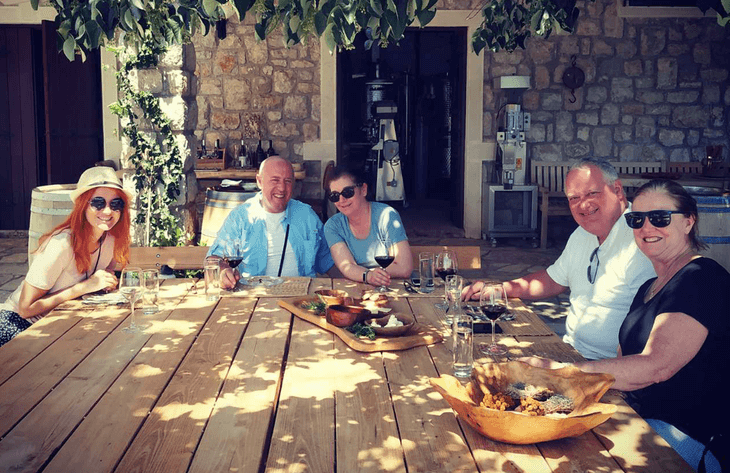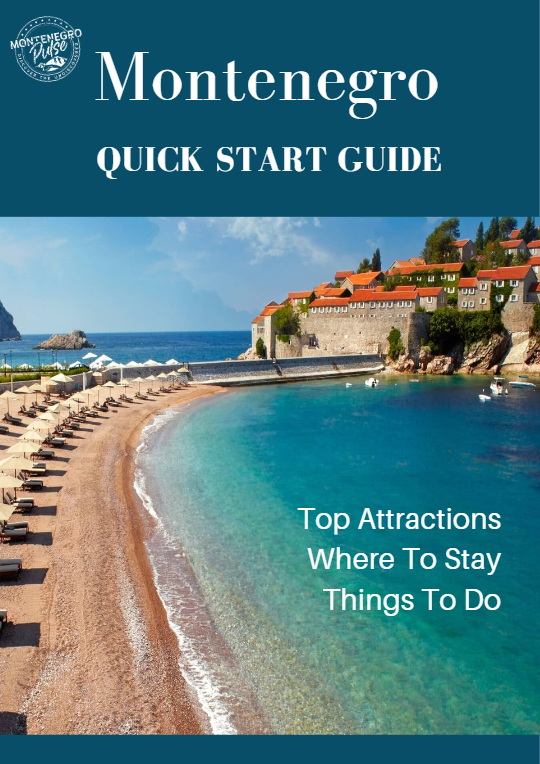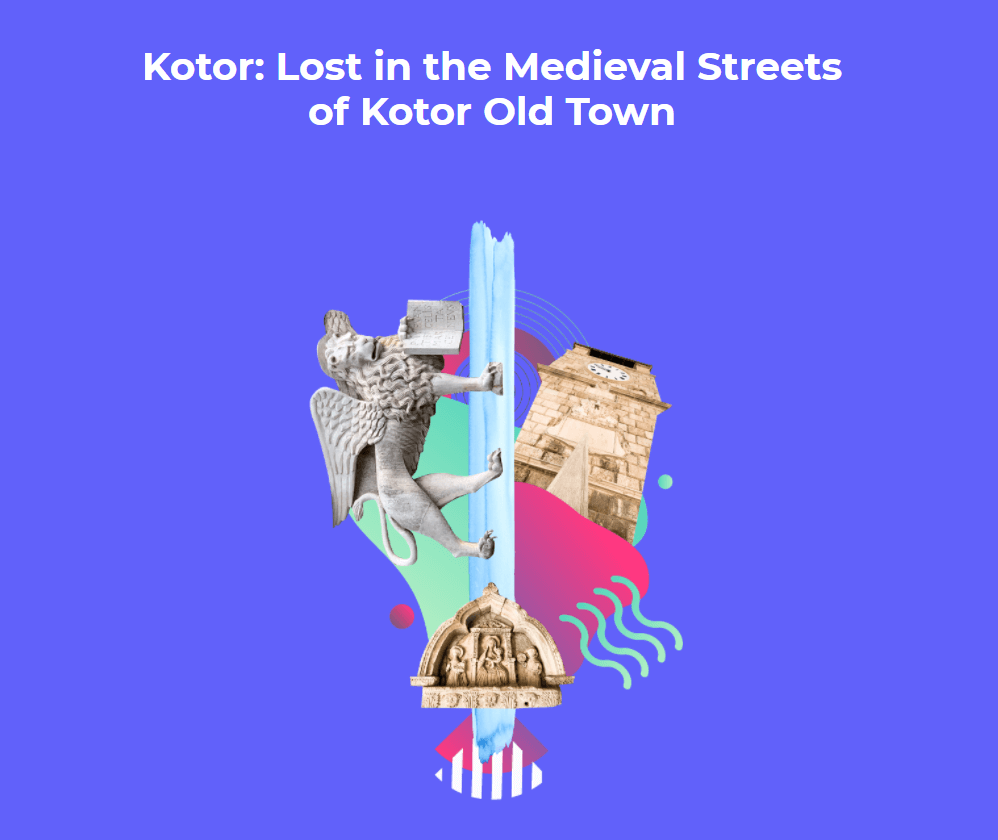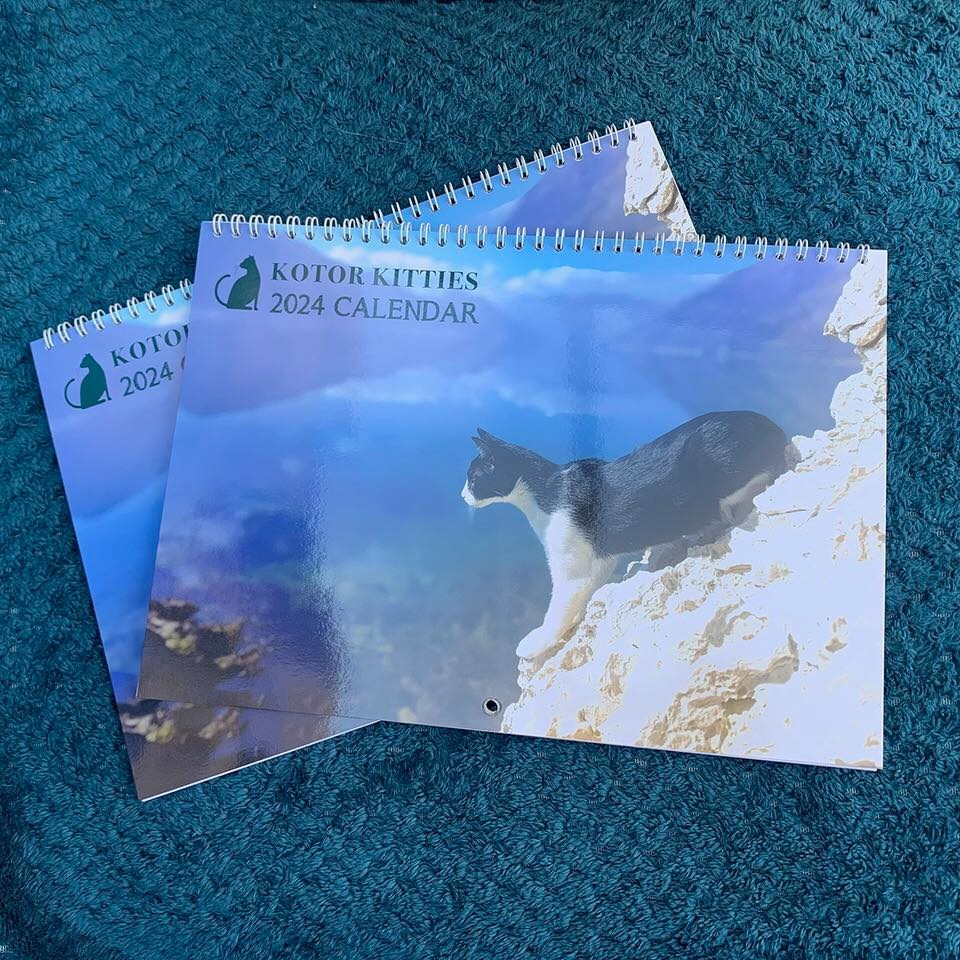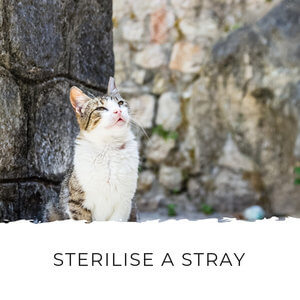Montenegro Pulse contains affiliate links and is a member of the Amazon Services LLC Associates Program. If you make a purchase using one of these links, I may receive compensation at no extra cost to you. See my disclaimer for more information.
Kotor Old Town: 15 Must-See Sights in Kotor Old City
BY SARAH
Kotor Old Town is one of Montenegro’s most photogenic, fascinating, and popular attractions. Every year visitors from all around the globe come to see this UNESCO World Heritage site on the shore of the Bay of Kotor, Montenegro.
Kotor’s cobbled streets and narrow alleyways offer a glimpse into its 2,000-year history. The cafes full of locals enjoying coffee in the sun and lively atmosphere give you an insight into Kotor’s modern culture.
No matter how long your stay in this unique town, no visit is complete without seeing some of the town’s top sights.
In this article, you’ll find the top 15 must-see sights in Kotor, Montenegro, including the town’s most beautiful palaces, town gates, and hidden gems. I’ll also tell you the best places to eat, to sleep and how to get there.
The beauty of Kotor's small size is that you can see all of them, even if you only have a day to spend in Kotor.
If you are visiting Kotor, read on to make the most of your visit.
Tips for Visiting Kotor Old Town
Kotor old town map – pick up a free Kotor old town map at the information kiosk in front of the Sea Gate. Having a map is essential for navigating the old town because of the windy streets that are so easy to get lost in.
If you have an internet connection, Google Maps works well too. With Google Maps you can always see exactly where you are in real time. You can pick up a local SIM card at newspaper kiosks for €10 or get an e-SIM from Airalo.
Look up! - as you wander through Kotor old town, look up and you'll see things most people miss. Beautiful Gothic windows and coats of arms of ancient nobility mixed with the laundry of Kotor residents. It all gives you a feeling for life in Kotor over the centuries.
Bring euros - You’ll need cash in euros to enter attractions like St Tryphon’s Cathedral, the Maritime Museum and the fortress hike. Don’t worry if you don’t have any on you, there are atms in Arms Square (Trg od Oružja) as you enter from the Sea Gate. You’ll also need cash for parking if you’re driving to Kotor old town, but you can pay with card in almost all shops and restaurants.
Wear good shoes - Kotor’s streets are paved with beautiful, old cobblestones but they’ve been worn down over the centuries and they’re very slippery. I recommend wearing trainers if you plan to do the Kotor walls walk up San Giovanni Fortress.
Bring cat food - the old town of Kotor has a large population of cats who’ll be grateful for a handful of kibble or a few slices of deli meat.
Book walking tour - walking tours of Kotor take you around the top sights in Kotor old town and give you a overview of the history and significance of the city of Kotor in just 1-2 hours. Click here to see my top picks.
15 Must-See Sights in Kotor Old Town
1. Saint Tryphon Cathedral
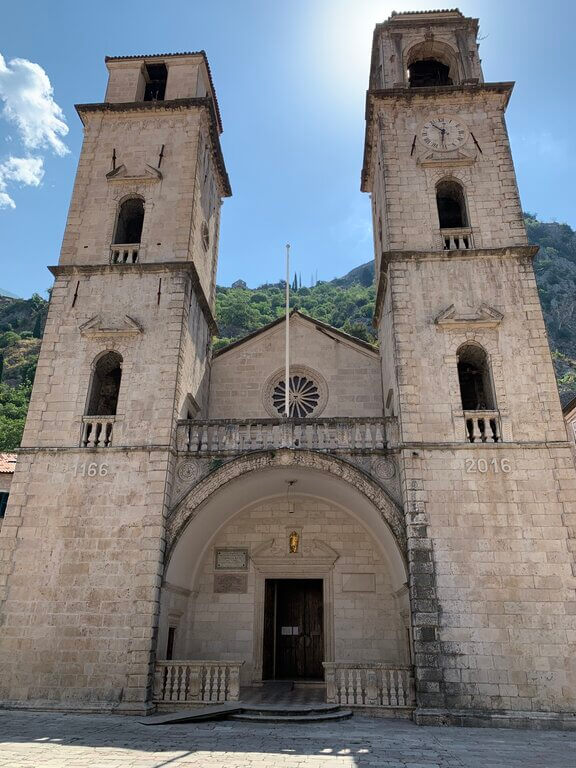
Saint Tryphon Cathedral is one of the most significant religious and architectural landmarks in Kotor Old Town.
Originally built in 1166, the cathedral has weathered earthquakes and invasions, yet remains remarkably well-preserved. It features a blend of Romanesque and Byzantine architectural elements, showcasing Kotor's diverse historical influences.
Inside, you can admire intricate frescoes, a treasury of religious relics, and a silver altar screen. The cathedral's twin towers offer panoramic views of the town and bay, making it a must-visit attraction.
Entrance: €4 per person for entrance to the museum
2. Sea Gate
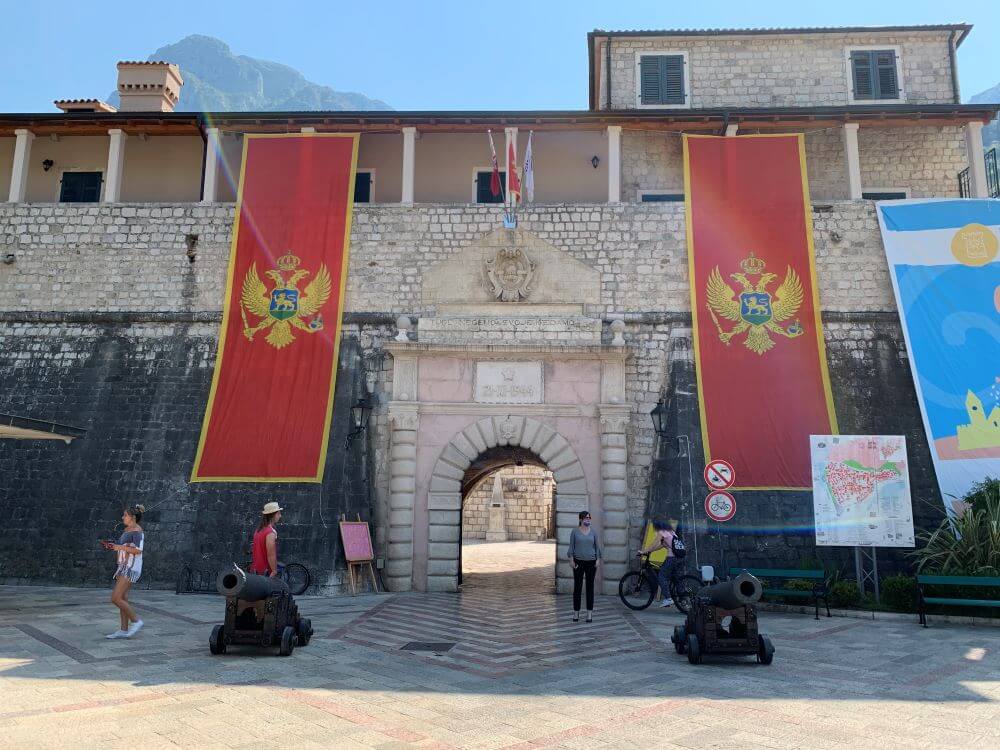
The Sea Gate is the main entrance to Kotor Old Town and is an iconic symbol of this town's rich history.
Built in 1555 during the Venetian rule, the gate covers an even older gate from the 13th century.
Originally, the gate was decorated with the Venetian winged lion, but now it bears a quote from Yugoslav president, Tito: Tuđe nećemo, svoje ne damo’ – ‘What belongs to others we don’t want, what is ours we will never surrender’.
Inside the gate, you’ll see a beautiful 15th-century relief that shows the Virgin Mary with Christ, Saint Tryphon, and Saint Bernard.

As you pass through the Sea Gate, you're immediately transported into the cobbled streets of the heart of Old Town Kotor, Weapons Square.
3. Weapons Square
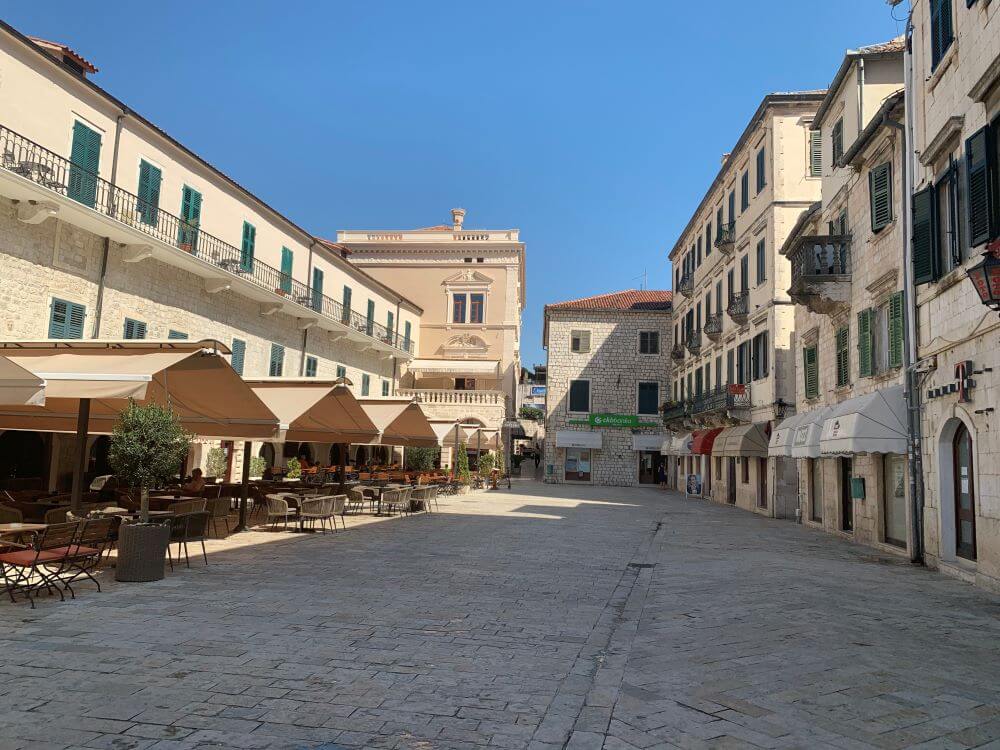
Weapons Square, also known as Arms Square, is the main square in Kotor Old Town and is the town's lively social center. The square is lined with cafes full of locals enjoying coffee with friends.
The outer wall of the square was once barracks and the Duke’s Palace.
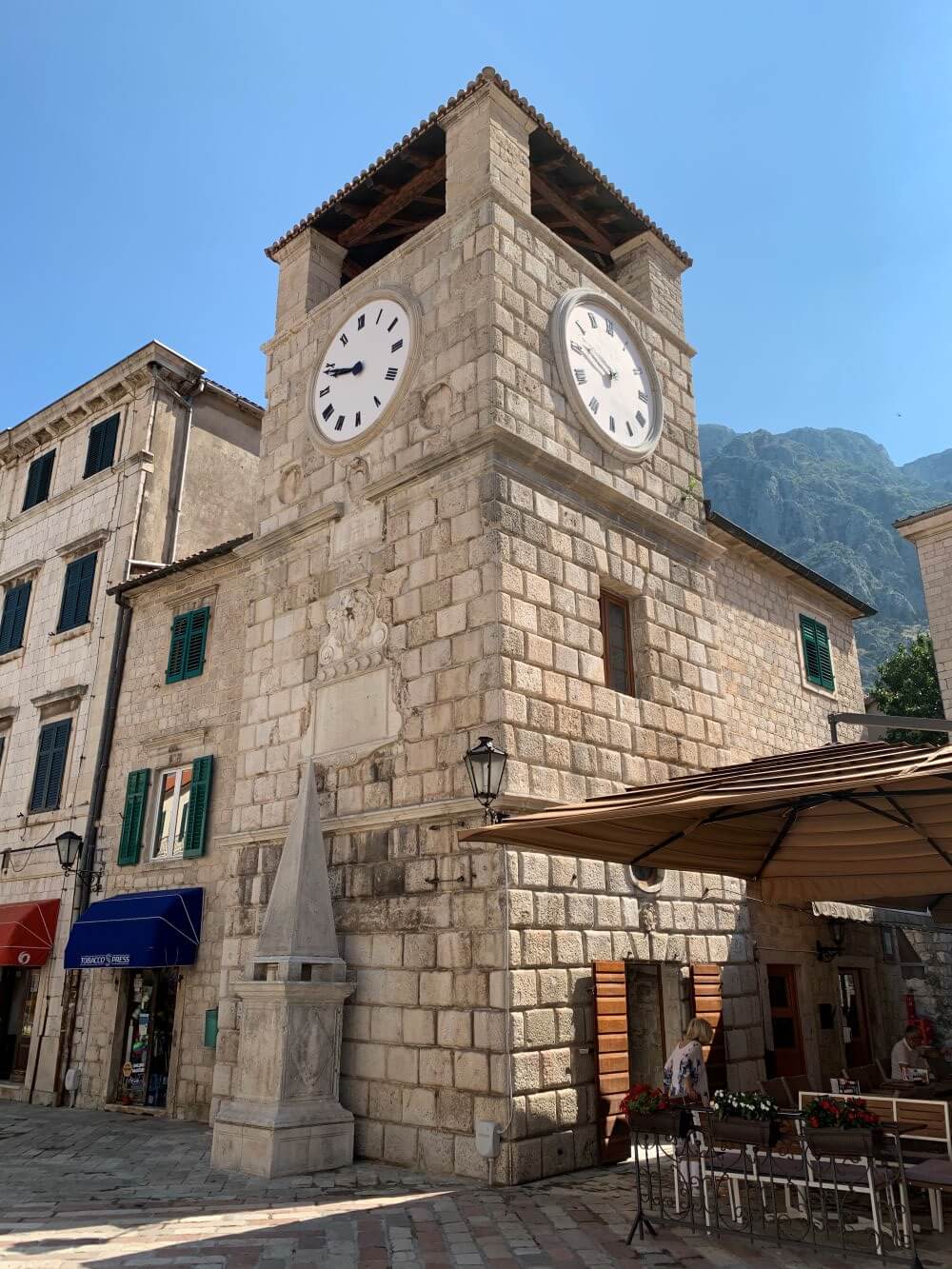
Historically, this was the area where arms and artillery were stored and Kotor’s defenses were based, hence its name. In the square, the 17th-century clocktower stands over the town pillory.
And at the far end of the square, today’s Historic Boutique Hotel Cattaro was one of Montenegro’s first theaters.
4. Karampana Fountain
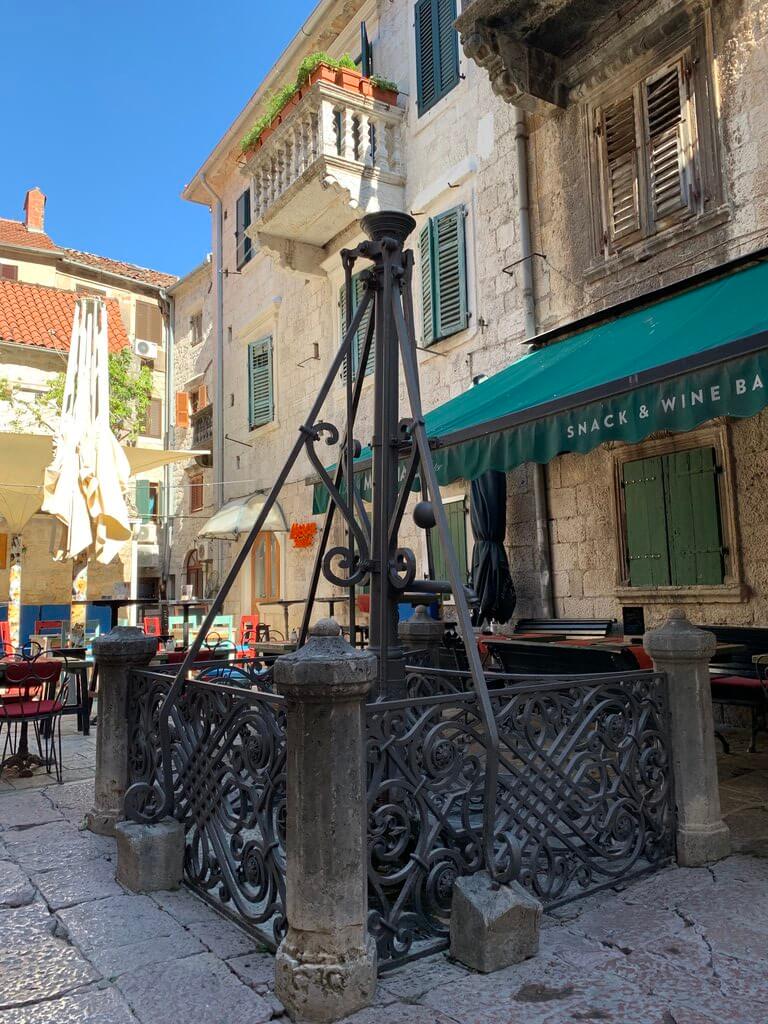
Kotor was historically supplied with fresh water from the Škurda River and Gurdić Spring. Noble houses had private wells, and Karampana Fountain served as the town's only public well until 1917 when modern plumbing was introduced by the Austrians.
The fountain was not just a water source; it was a social hub where people, especially women, gathered to gossip. While the exact origin of the fountain's name is unclear, theories range from it meaning an old, broken item to a possible link to a 14th-century Venetian brothel named Ca’Rampani.
5. Maritime Museum
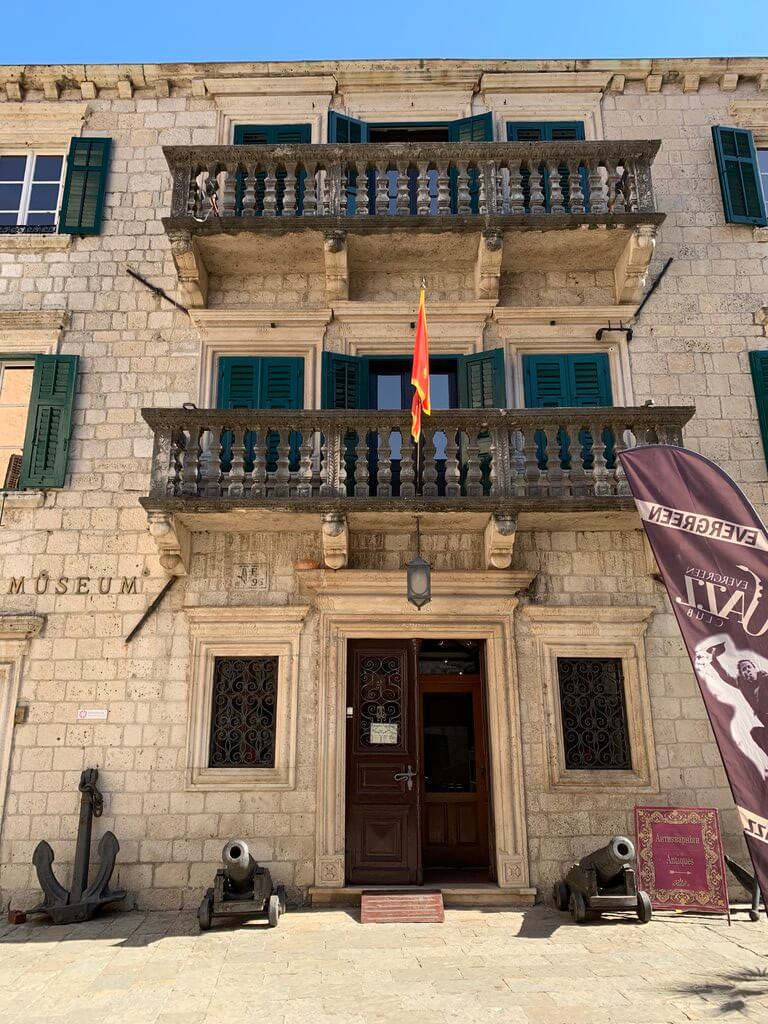
Kotor gained its wealth and power as a trading port that connected the Serbian Nemanjić Dynasty with the rest of Europe and its history and culture are inextricably intertwined with the sea.
The maritime museum’s three floors are filled with beautiful examples of the area’s history including clothing, weapons, and furniture.
The entrance fee includes an audio guide and you can easily spend an hour here admiring traditional dress, artwork, and artifacts from the bay.
Hours:
15th April - 1st July: 8 am - 6 pm Monday - Saturday, 9 am - 1 pm
Sundays and public holidays
1st July - 31st August: 8 am - 11 pm Monday - Saturday, 10 am -
4 p.m. Sundays and public holidays
1st September - 15th October: 8 am - 6 pm Monday - Saturday,
9 am - 1 pm Sundays and public holidays
15th October - 14th April: 9 am - 5 pm Monday - Saturday, 9 am
- 12 pm Sundays and public holidays
Entrance: €4 per person with an audio guide
6. Pima Palace
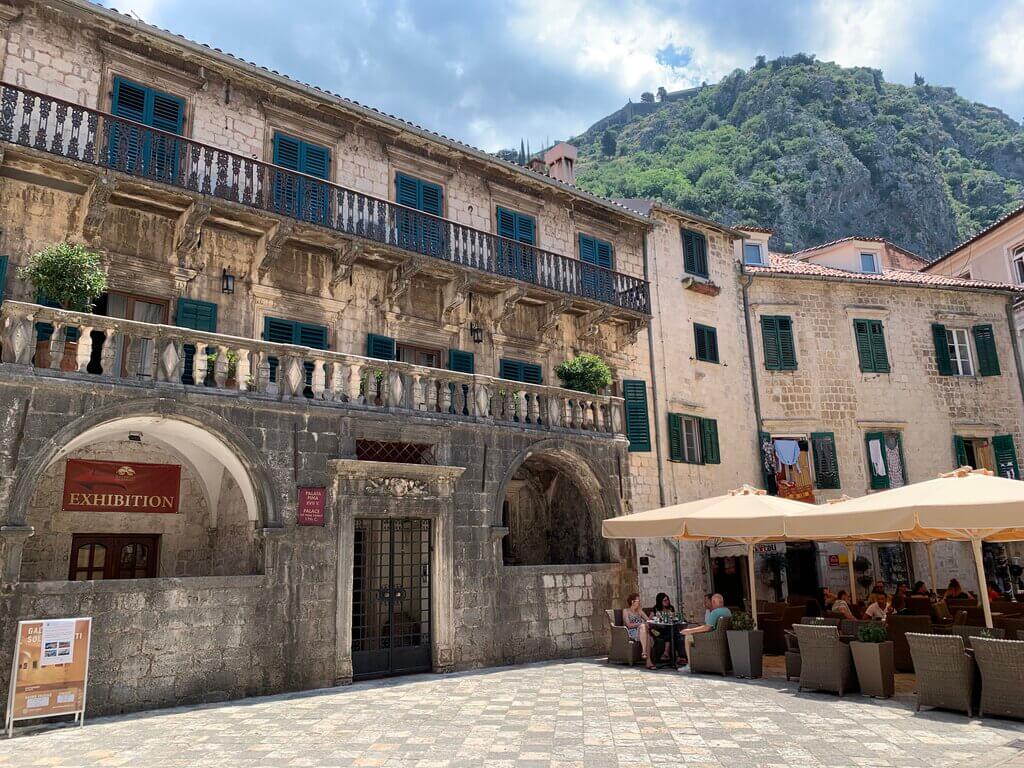
Pima Palace, a stunning 17th-century palace, is a testament to the city's rich history and architectural elegance.
Built by the once-prominent Pima family, the palace is a blend of Baroque and Renaissance styles, featuring ornate window frames and an interior courtyard. Its second-floor balcony is supported by intricate consoles and boasts a wrought iron fence crafted by Kotor’s blacksmiths, who were renowned for their skill at the time.
Now serving as the Gallery of Solidarity, the palace displays art mainly from Yugoslav artists of the 1970s.
Hours: Daily from 9 am to 2 pm and 5 pm to 9 pm
Entrance: Free
7. Saint Luke’s Church
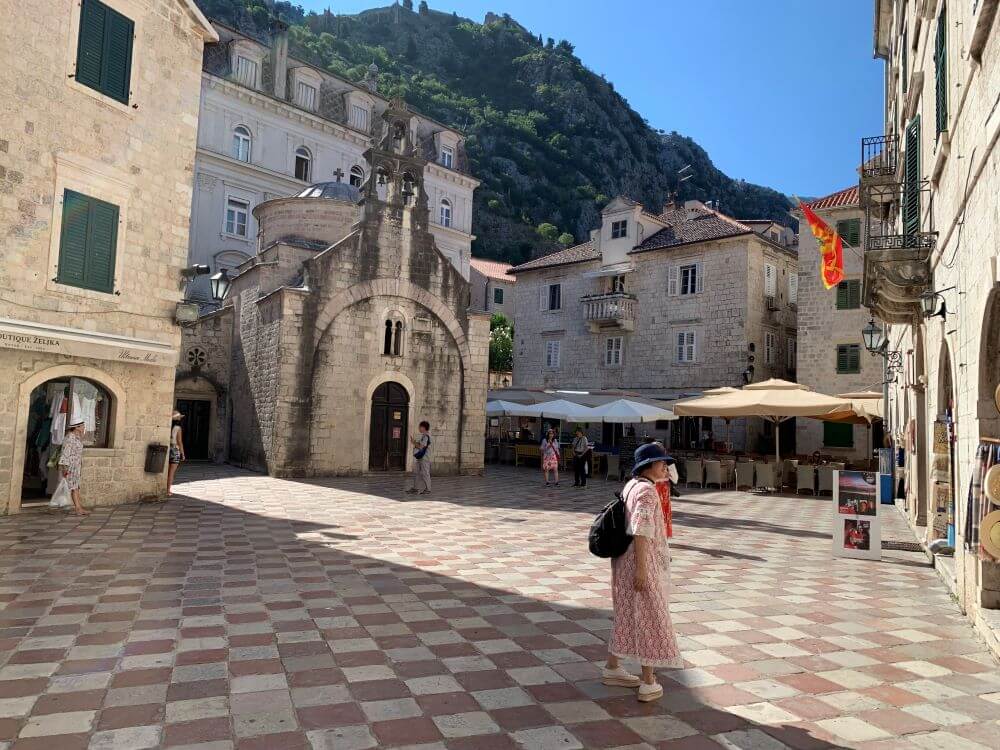
Next to Saint Tryphon Cathedral and Saint Nicholas’ Church, Saint Luke’s (Sveti Luka) is a relatively unimposing building, but it’s one of the most important in Kotor.
The church was built in 1195 and inside you’ll be able to see some of the original frescoes from the time it was built.
Originally Saint Luke’s was a Catholic church, but became Orthodox in 1657, when it was given to Kotor’s Orthodox citizens, particularly those who had fled the Ottoman Turk invasion the year before.
It kept a Catholic altar until 1812 and both Catholic and Orthodox masses were performed here.
Incredibly, it was the only building in Kotor that wasn’t significantly damaged in the 1979 earthquake that brought down buildings from Dubrovnik to Bar, on Montenegro’s south coast.
Bokelji (Bay of Kotor residents) still hold Saint Luke’s dear as an example of the bay’s traditional religious freedom and tolerance.
8. Saint Nicholas’ Church
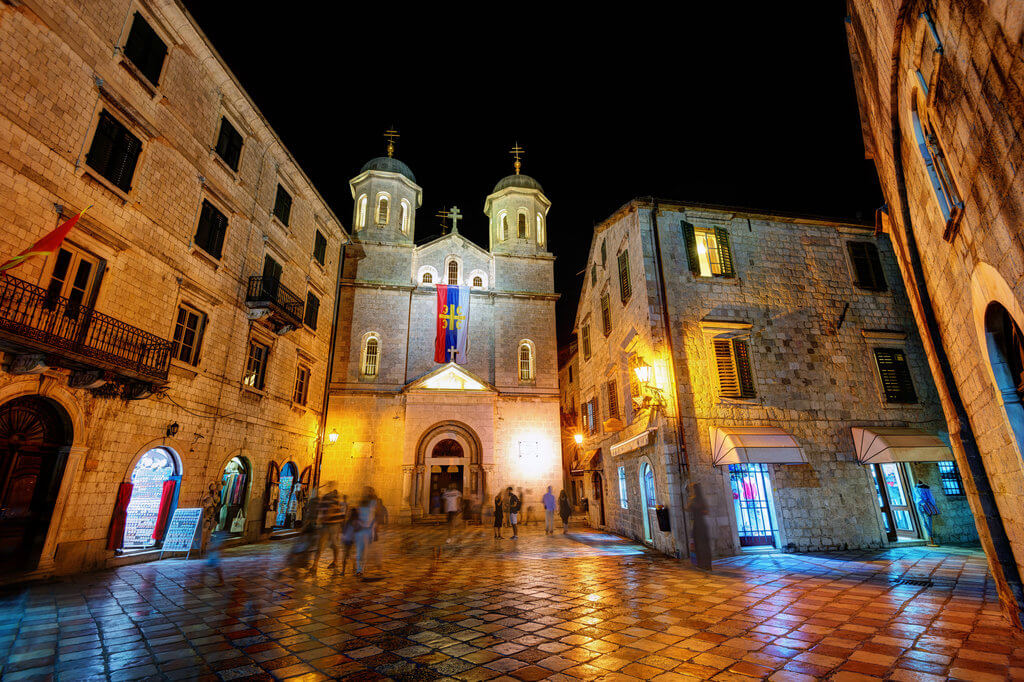 Saint Nicholas' Church. Image: Deposit Photos
Saint Nicholas' Church. Image: Deposit PhotosSaint Nicholas’ Church (Sveti Nikola) is a Serbian Orthodox church that dominates Saint Luke’s Square (Trg Svetog Luka).
You’ll recognize it by the twin domed towers and the flag that hangs down the center. It’s a relatively new building, completed in 1909 after a fire ruined the original church that was built in 1810.
Inside, Saint Nicholas' has beautiful iconostasis from the 15th to 19th centuries and you can light candles and give prayers for your loved ones.
9. Saint Mary’s Church
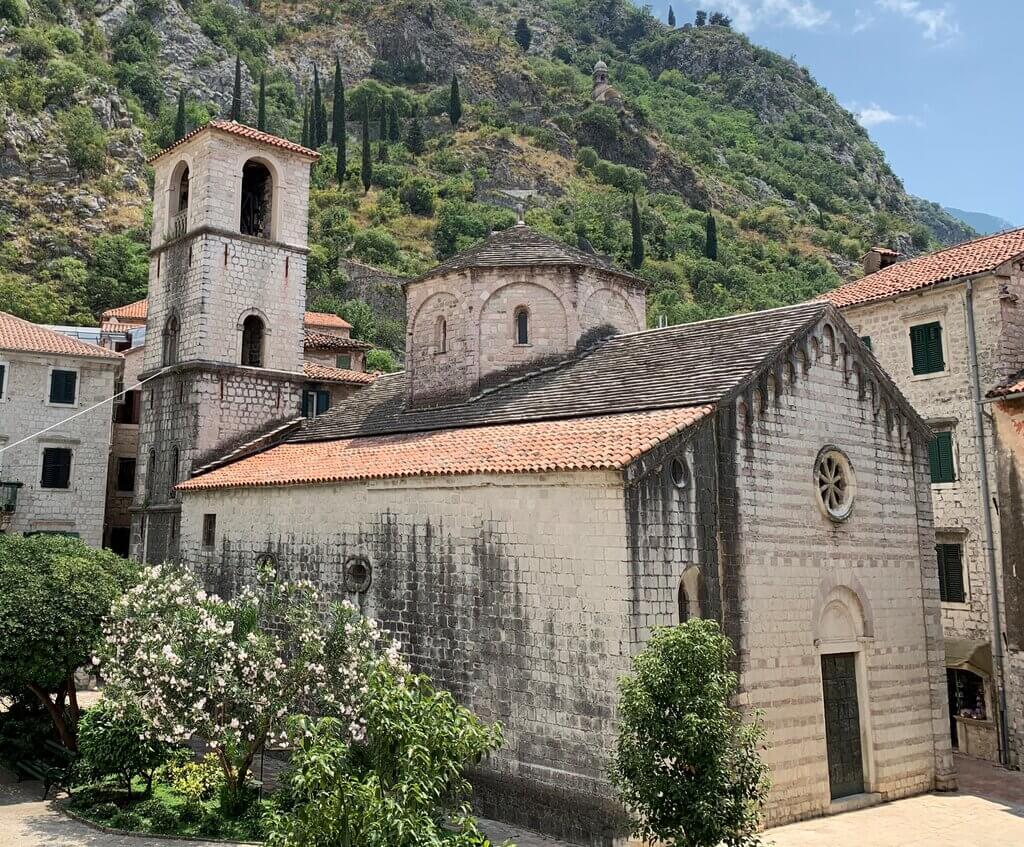
Saint Mary's Church in Kotor was consecrated in 1221 and built on the remnants of a 6th-century Christian church, which was believed to be Kotor's bishopric.
The church features a bronze bas-relief door depicting the life of Blessed Osanna of Cattaro, made by artist Vasko Lipovac.
Osanna of Cattaro was an Orthodox shepherdess who converted to Roman Catholicism and became an anchorite. She spent 52 years in a cell at Saint Paul's church and was credited with saving Kotor from a plague and an Ottoman attack in 1539.
10. River Gate
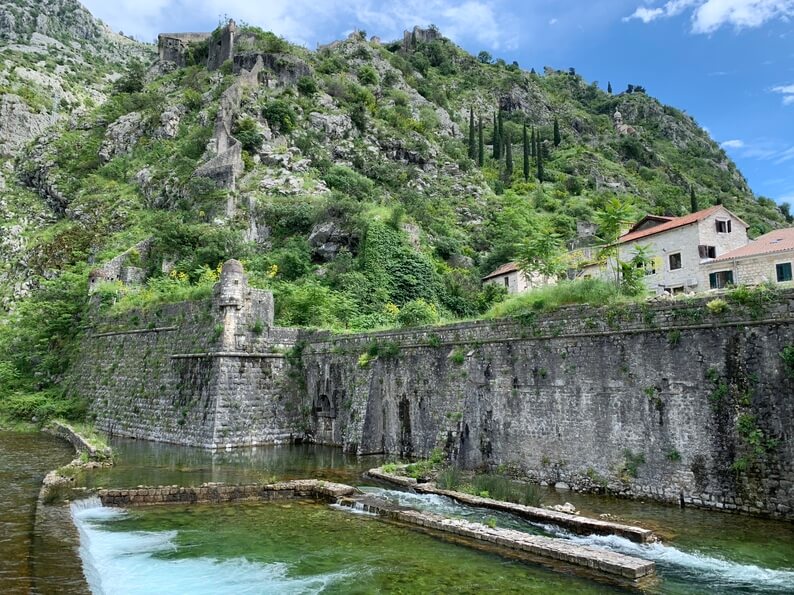
The River Gate was built in the 16th century to commemorate the failed Ottoman attack of 1539. This gate is located on the northern side of the town, facing the Škurda River.
The River Gate is flanked by ancient stone walls and a small bridge that crosses the river. It’s a great place to take pictures of Kotor’s walls.
11. Wood Square aka Cat-Lover’s Heaven
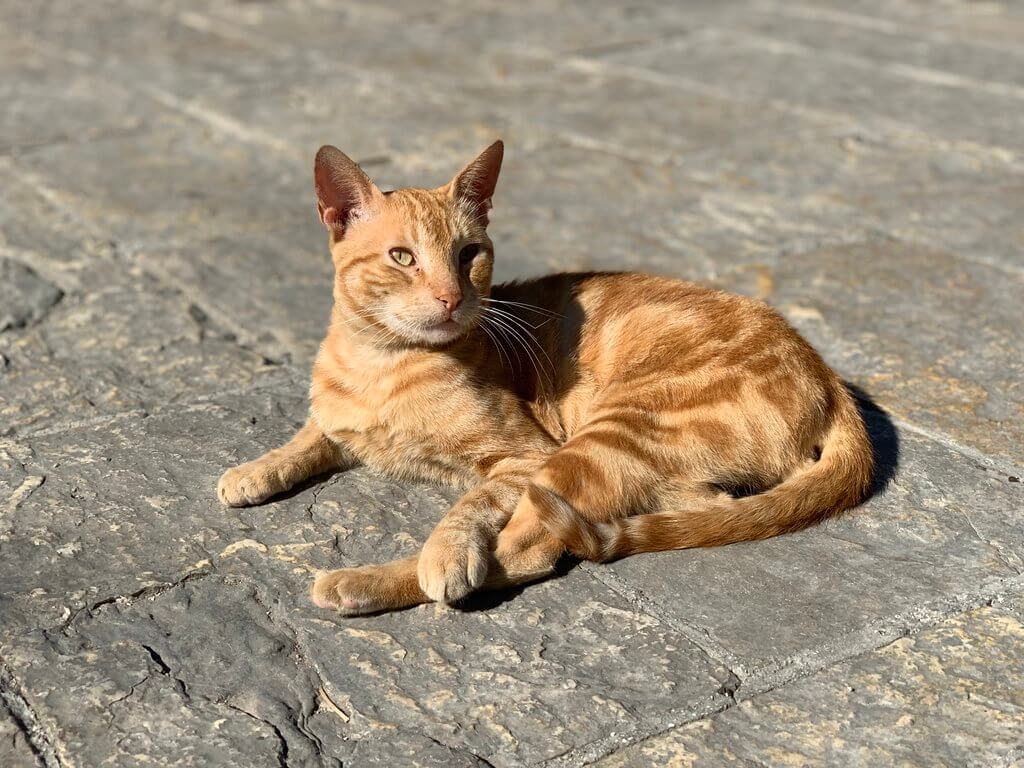
Wood Square is named for the wood that was sold in this square. It's also where you'll find the River Gate and be able to get a good view of the Škurda River, find the entrance to the hike up Kotor city walls and St Mary's Church.
But, these aren't what bring thousands of tourists here.
Rather, it's Kotor's four-legged unofficial mascots that capture the hearts of visitors to Wood Square.
Wood Square is a gathering place (and unfortunately dumping spot) for cats in Kotor. There are small houses which shelter the vulnerable kittens and they know they'll find food here.
Visitors to Kotor love to sit on the benches and pet the cats, who have learned that tourists are an excellent source of both affection and food.
So make a little time to visit Wood Square, relax and soak up the ambiance of Kotor.
While Kotor's cats might look like they have it good while they're lazing in the sun and lapping up attention from tourists, the truth is all of these cats have been abandoned here, most as very young kittens.
Life is hard on the streets, especially in winter when it's cold and the steady stream of food dries up along with the tourists. Overcrowding means disease is rife, especially the deadly feline parvovirus that kills 90% of these kittens.
Luckily, there is one organization and a handful of committed volunteers to help. Kotor Kitties is a US-, UK- and Montenegro-registered charity that provides sterilization and aid to Kotor's unofficial mascots.
Click here to find out more about Kotor Kitties' work.
If you’d like a cat-themed souvenir to take home, you can find hand-made gifts and souvenirs at Danijela’s Cats, which is in the alley opposite Saint Anne’s Church (#26 on the free Kotor map you get by the Sea Gate).
Danijela, the owner, feeds, sterilizes, and cares for a huge number of cats and kittens in Kotor Old Town and you can rest assured shopping there will help Kotor’s furry mascots!
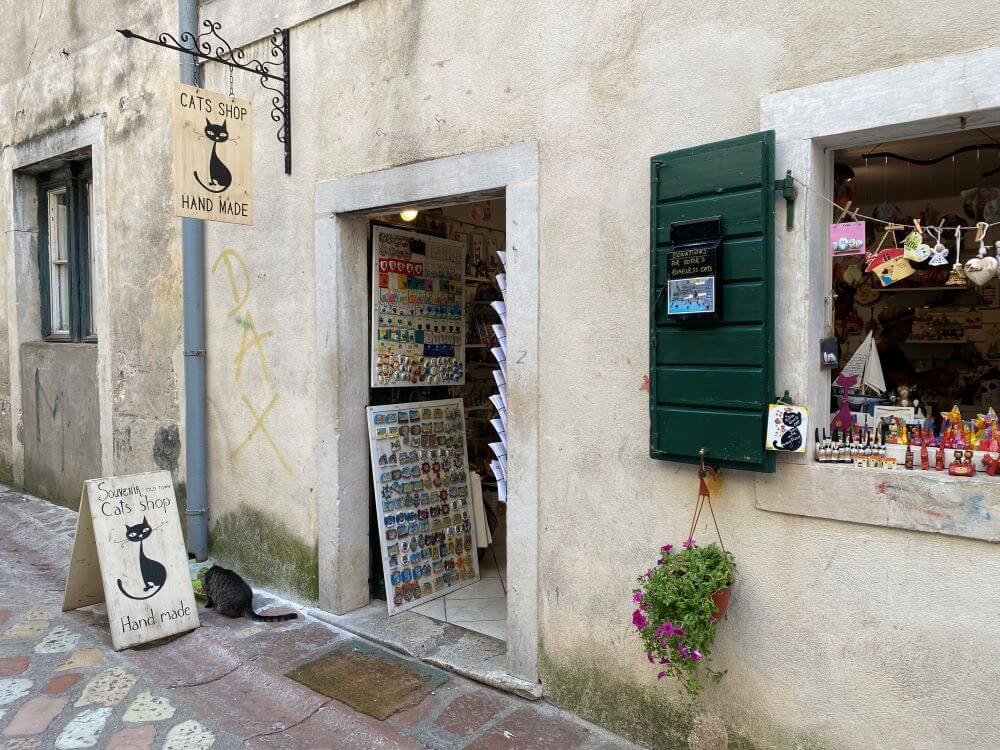
12. Kampana Tower
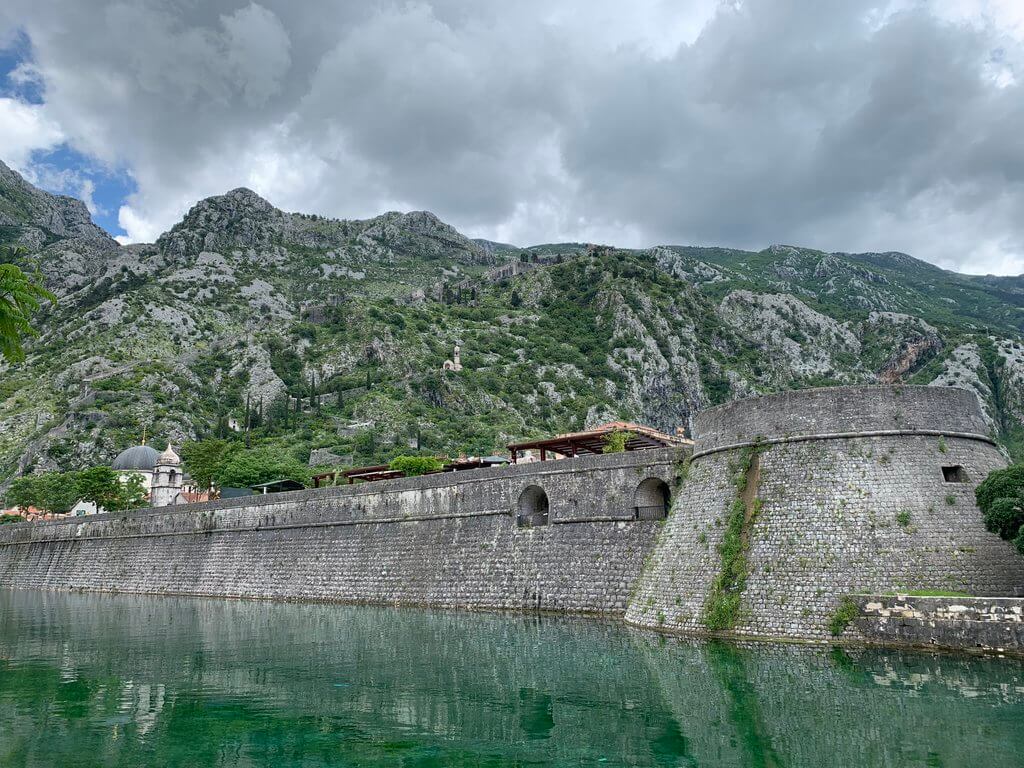
Kotor’s fortifications are one of its most remarkable features. You’ll see the fortifications encircle the whole old town and a part of the mountain above.
In fact, Kotor is one of few towns in the Mediterranean to have completely kept its fortification system.
The building was most intense during the 13th and 14th centuries, and by the end of the 14th century they completely encircled Kotor town and the castle above.
With advancements in fire arms and the threat of Turkish invasion looming, the walls had to be strengthened and thickened throughout the 15th century. The walls are an incredible 4.5km (2.7mi) in length and reach up to 20m (65ft) high and 16m (52ft) thick!
The easiest way to see the fortifications is to take the staircase from Wood Square or behind Historic Boutique Hotel Cattaro up to Kampana Tower.
From here you’ll be able to walk the section along the Škurda River, see the fortifications going up Mount Saint John and, after that minor exertion, relax with a cold Nikšičko beer (Montenegro’s national brew) at the café on the tower.
However, if you have a couple of hours (and don’t mind a little sweat!) I encourage you to take on Kotor’s rite of passage: the San Giovanni fortress hike or even the Ladder of Kotor.
13. San Giovanni Fortress
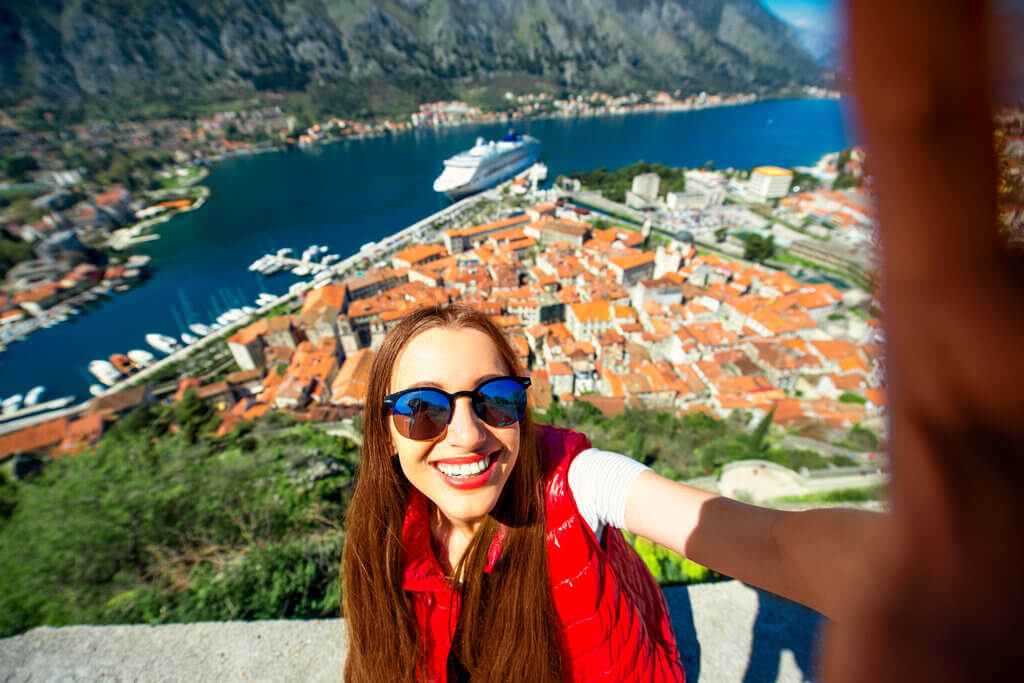 View from the top of Kotor city walls. Image: Deposit Photos
View from the top of Kotor city walls. Image: Deposit PhotosThe fort atop Mount Saint John (also known as Sveti Ivan and San Giovanni) was built 280m above sea level by the Illyrians somewhere between the 3rd century B.C and 168 B.C.
Through successive empires it was expanded and became part of Kotor's defensive wall.
The Kotor fortress walk to San Giovanni Fortress is one of Kotor’s top attractions and you’ll get incredible views of Kotor and the Bay of Kotor all the way up. However, it’s not an easy walk, especially if you’re doing it in summer heat.
There are 1355, sometimes crumbling, steps to the top and in many places you’ll be forced to walk on the gravel slope because the steps are single file. Coming prepared will make a huge difference!
The walk is 1.2km (0.7mi) and the entrance is next to #42 on the map. Don't forget to look up and see the Venetian arch above the street on your way through!
If you have time, follow the sign for Špiljari Village on your way up. This is where Kotor was founded over 2,000 years ago. You can explore the ruins and 1,000 year old Church of St John.
You can also visit the makeshift cafe for some rakija (brandy), juice and cheese.
The hike takes about 2 hours to complete, depending on your pace. The path is well-marked but can be steep and rocky, so I recommend wearing sturdy shoes.
Entrance: €8 per person
Pro Tips
- The best times to undertake the hike are in the early morning or late afternoon to avoid the heat.
- You’ll get the best views of the bay in the morning.
- Bring water and snacks (including cat food if you would like to feed the stray cats on the trail) because there are no facilities along the trail.
- Carry a flashlight if you plan to descend after dusk as the trail is not well-lit.
14. Let Me Pass St
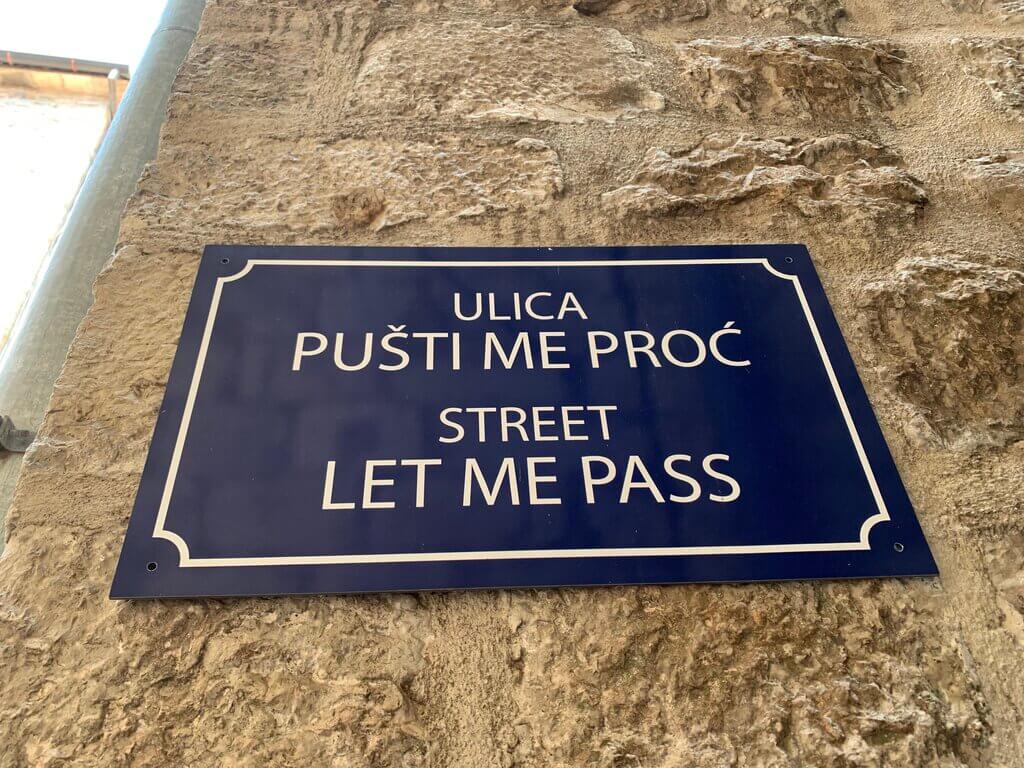
"Let Me Pass" street is one of my favourite off-the-beaten-track things to see in Kotor.
Legend has it that long ago, two stubborn merchants who were carrying large sacks of goods got stuck in this narrow street, refusing to yield to each other. After hours of impasse, they finally agreed that the street should be named "Let me pass" in honor of their dispute.
Today, this quirky street is a hidden gem and delightful reminder of Kotor's unique personality that make this charming town in Montenegro truly special.
You'll find it beside Casa Antica Druško and Boutique Hotel Hippocampus in the old town.
15. Shop at Kotor Farmers Market
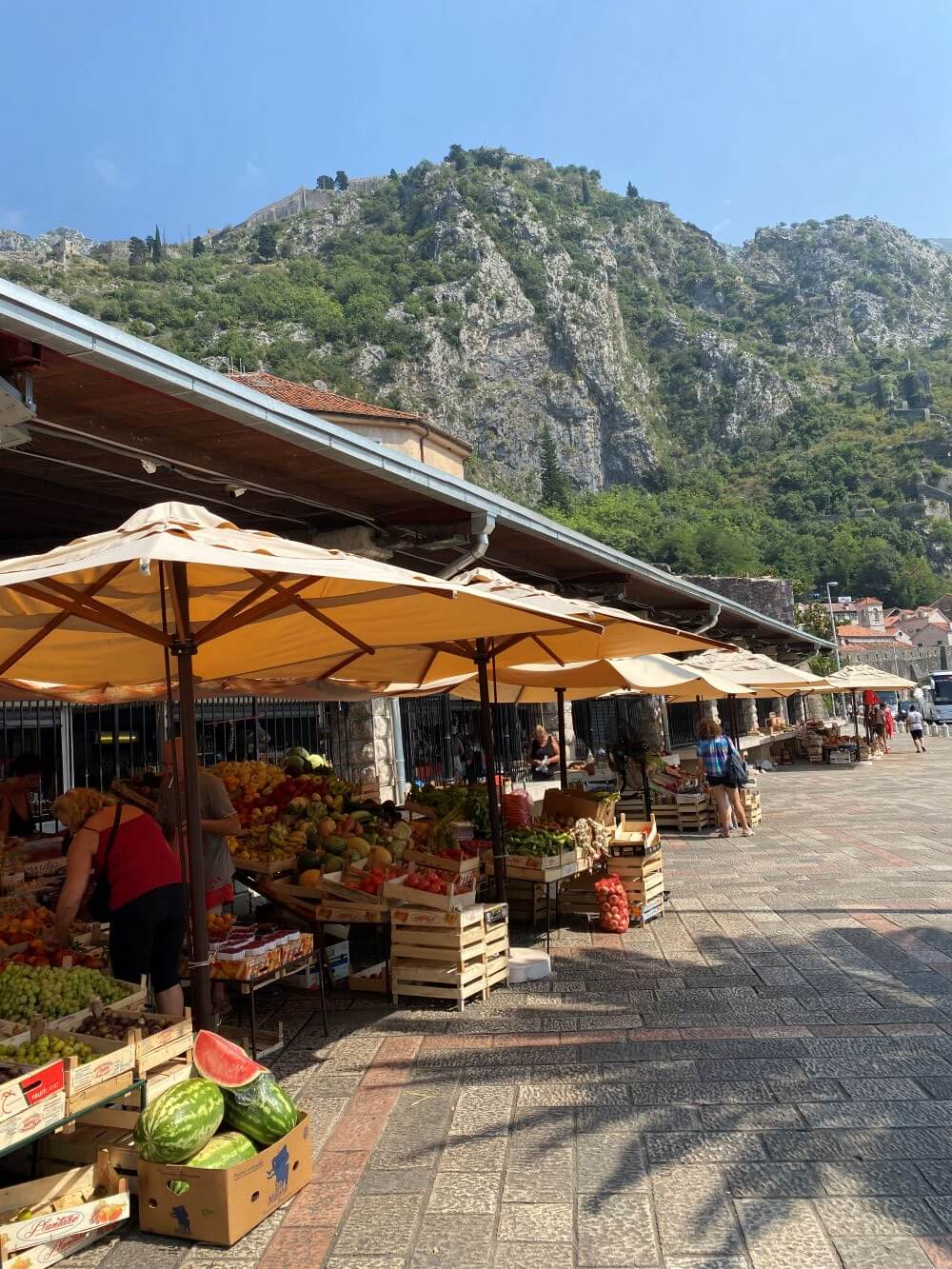
There has always been a market in Kotor because of the lack of space to grow food inside the town. Farmers from inland Montenegro would bring their produce down the Ladder of Kotor to sell it in the town.
Just outside the town walls you’ll find vibrant arrays of local produce. This is one of the best places to taste Montenegro's fresh produce.
If you want to try traditional fare pick up some olives marinated in garlic and parsley, round cheeses, olive oil, pomegranate juice, prosciutto, fresh-caught fish, figs, honey, berries, tomatoes, cucumbers, capsicums, and potatoes. Anything labeled domači is locally grown.
Hours: 8am to 2pm daily
Best Ways to See Kotor Old Town’s Sights
The easiest way to see Kotor old town is on a Kotor Old Town walking tour. These tours take you around the most important sites in the old town and tell you about the history and significance of each.
They're a great way to see Kotor's top sights and get a general overview of the town in just 1-2 hours.
Private Kotor Walking Tour - on this private tour you visit all of Kotor's main attractions and you get a guided tour through top sights, St Tryphon Cathedral and the Maritime Museum. Click here to read more about this tour.
Group Kotor Walking Tour - This small group walking tour takes just over and hour and takes to the highlights of the old town. Click here to check pricing and availability.
Kotor Secret City Trail - this scavenger hunt x walking tour is a really fun way to explore Kotor old town! Solve the riddles to unlock fascinating stories as you follow the clues around the old town. *Use the code 'montenegropulse' to get an exclusive 10% discount on this trail. Click here to read more.
Kotor Self-Guided Walking Tour - if you prefer to explore Kotor independently, I recommend getting a copy of my guide to Kotor to take with you. The book allows you guide yourself around even more attractions than you'd see on a Kotor city tour, plus it takes you to some hidden gems only we locals know about. Click here to find out more.
Kotor Old Town Restaurants
Kotor Old Town has some excellent restaurants and I highly recommend trying some local cuisine while you’re here.
Konoba are traditional-style restaurants and are the best places to find local-style cuisine. As a seaside destination, local dishes feature a lot of seafood and fresh produce.
The Kotor Private Walking Tour with Wine and Food Tasting is a great way to combine both a walking tour with local cuisine, especially if you’re short on time.
Recommended Local Dishes and Delicacies
- Black risotto - made with cuttlefish ink, black risotto is a delicious local delicacy.
- Fish - sea bass and bream served with dalmatian sides and seasonal salads are a classic favourite in the Bay of Kotor.
- Seafood buzara - this traditional stew is made with wine and garlic and includes seafood like mussels, prawns, and shellfish.
- Prosciutto, cheese and olives - just above Kotor, the village of Njeguši is famous for its excellent quality prosciutto and cheeses. Try a mezze of prosciutto, cheese, olives and wine.
- Balkan grill - Balkan grill features (čevapi), hamburger patties (pljeskavica), and other grilled meat. They usually come with fries and you choose a salad to go with them. The šopska salad (tomato, cucumber, onion, capsicum and feta cheese) is always good, as is a simple, dressed cabbage salad. My favorite is pljeskavica na kajmaku (hamburger with Balkan clotted cream)!
- Kotorska pašta - Kotor’s traditional dessert is made of alternate layers of thin pastry and a creamy custard filling.
- Vranac wine - this full-bodied red wine is made by wineries around Montenegro and is the traditional wine of this region.
- Rakija - this fruit brandy is a household staple throughout the region. Beware, rakija usually has an alcohol content of around 80%!
Kotor Old Town Restaurants
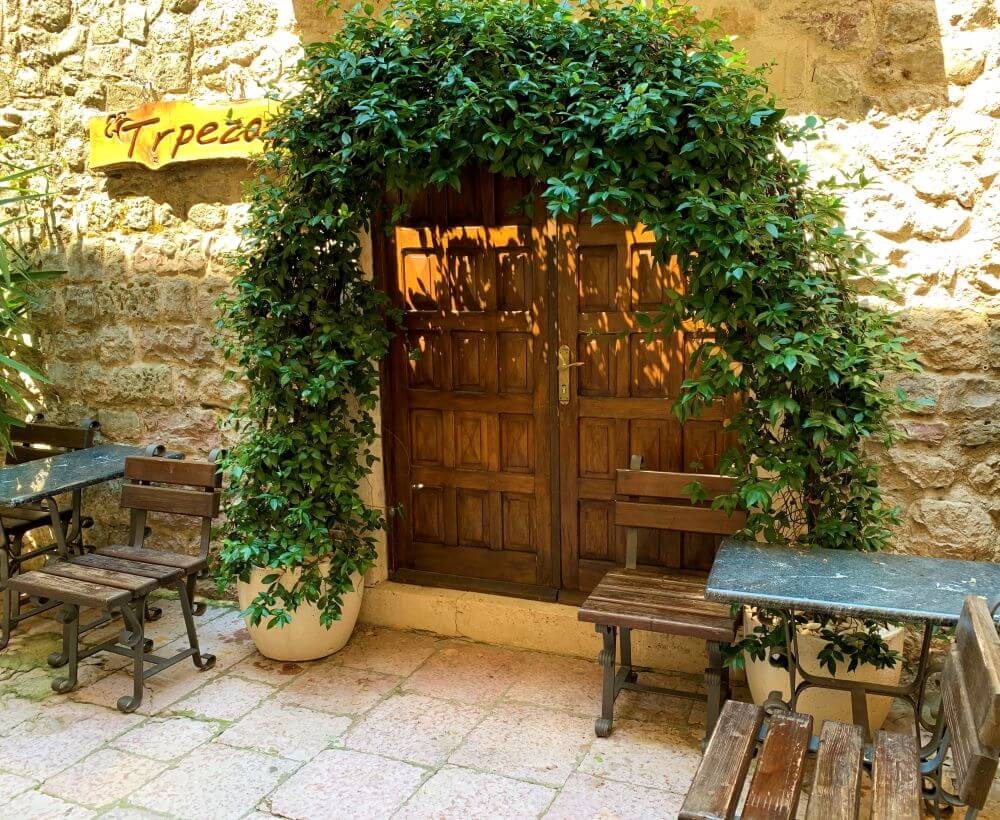
Konoba Skala Santa - one of the oldest restaurants in Kotor, and specializes in traditional cuisine and atmosphere.
Konoba Trpeza - set in an 800-year-old building with an intimate rooftop terrace, Konoba Trpeza specializes in traditional Bay of Kotor cuisine made from fresh locally sourced produce.
Bastion - Bastion II in Wood Square and Bastion III just across the bridge at the River Gate serve good value traditional-style meals and offer an authentic experience.
Pizza Pronto - it’s not strictly traditional fare, but I can’t help stopping by Pizza Pronto whenever I’m in Kotor. You can buy delicious, freshly-made pizza by the slice or order whole pizzas in their tiny restaurant. There’s always a queue here, but the pizza is worth it.
Read more: Best Kotor Restaurants

Where to Stay in Kotor Old Town
Kotor Old Town is an excellent place to stay while you visit Kotor.
It’s not often that you get the chance to stay in a 15th century Venetian town and Kotor Old Town has a lot of good-quality accommodation on offer, often at surprisingly affordable prices.
Aside from being beautiful and unique, when you stay in Kotor you have everything on your doorstep. Attractions, restaurants, even beaches are within walking distance.
There are also a lot of day tours like the hugely popular Full-Day Montenegro Tour and Durmitor, Tara and Ostrog Monastery Tour departing from Kotor. So, if you don’t want to hire a car, Kotor is the ideal place to stay.
But before you book your stay here you should know that the Old Town can be noisy.
With tourists wandering around all day and bars open until 1am, it’s not the ideal place to stay if you like peace and quiet. But, if you’re visiting in the winter months (November to April), Kotor is very quiet and is the ideal place to stay.
If you think the old town might be too noisy, you can also stay just outside of Kotor in Dobrota or Muo. There are lots of beautiful hotels and self-contained apartments on the seaside near Kotor and you’ll have the advantage of sea views.
Budget Accommodation
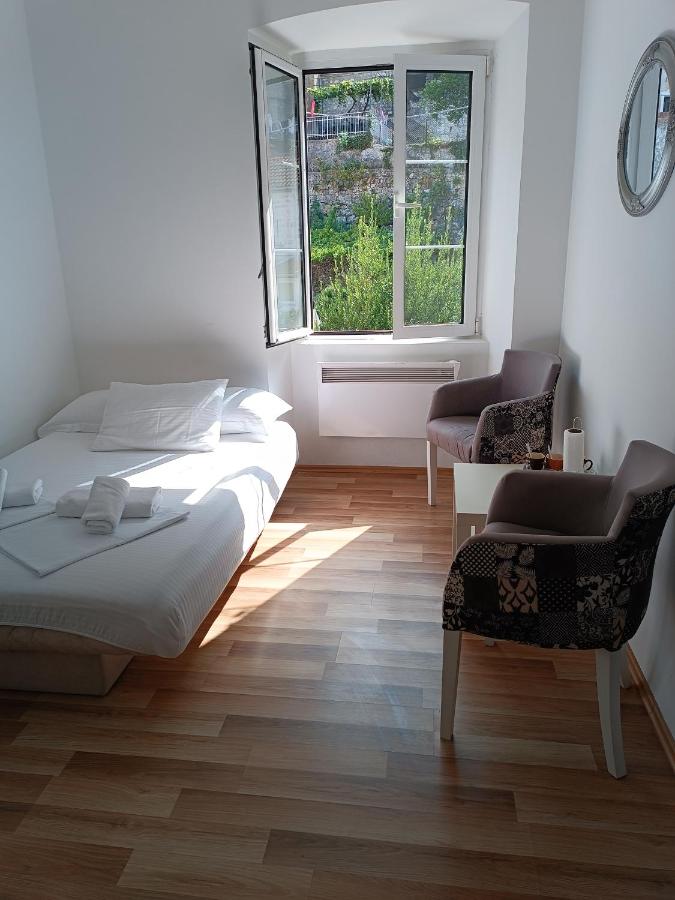
RATING: 9/10 | LOCATION: Kotor old town | BOOK NOW
If you're seeking budget-friendly lodging in a tranquil area of Kotor's historic center, Guesthouse BiT offers you good quality rooms at a great value. This serves as a wonderful alternative if hostels aren't to your liking. While the bathrooms are shared, your bedroom remains private.
With nightly rates starting at just €30, you'll find excellent value for a stay in such a prime location.
Mid-Range
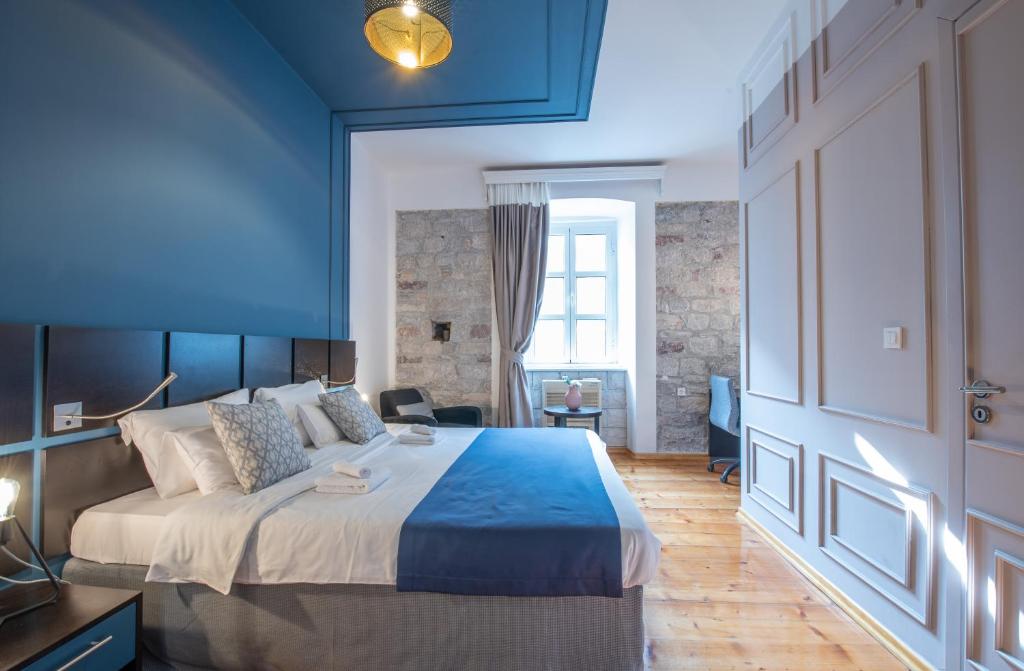
RATING: 8.9/10 | LOCATION: Kotor old town | BOOK NOW
Kotor Nest offers well-appointed and cozy rooms in Kotor's historic center. Each elegant room is equipped with a private bathroom, air conditioning (essential for the summer months), and select rooms feature a private balcony.
This 4-star lodging has a communal kitchen, which gives you the option to prepare your meals in addition to dining out. Individual fridges are available in each room for personalized food storage.
If you’re looking for chic yet budget-friendly accommodation, Kotor Nest is an excellent option within the old town.
luxury
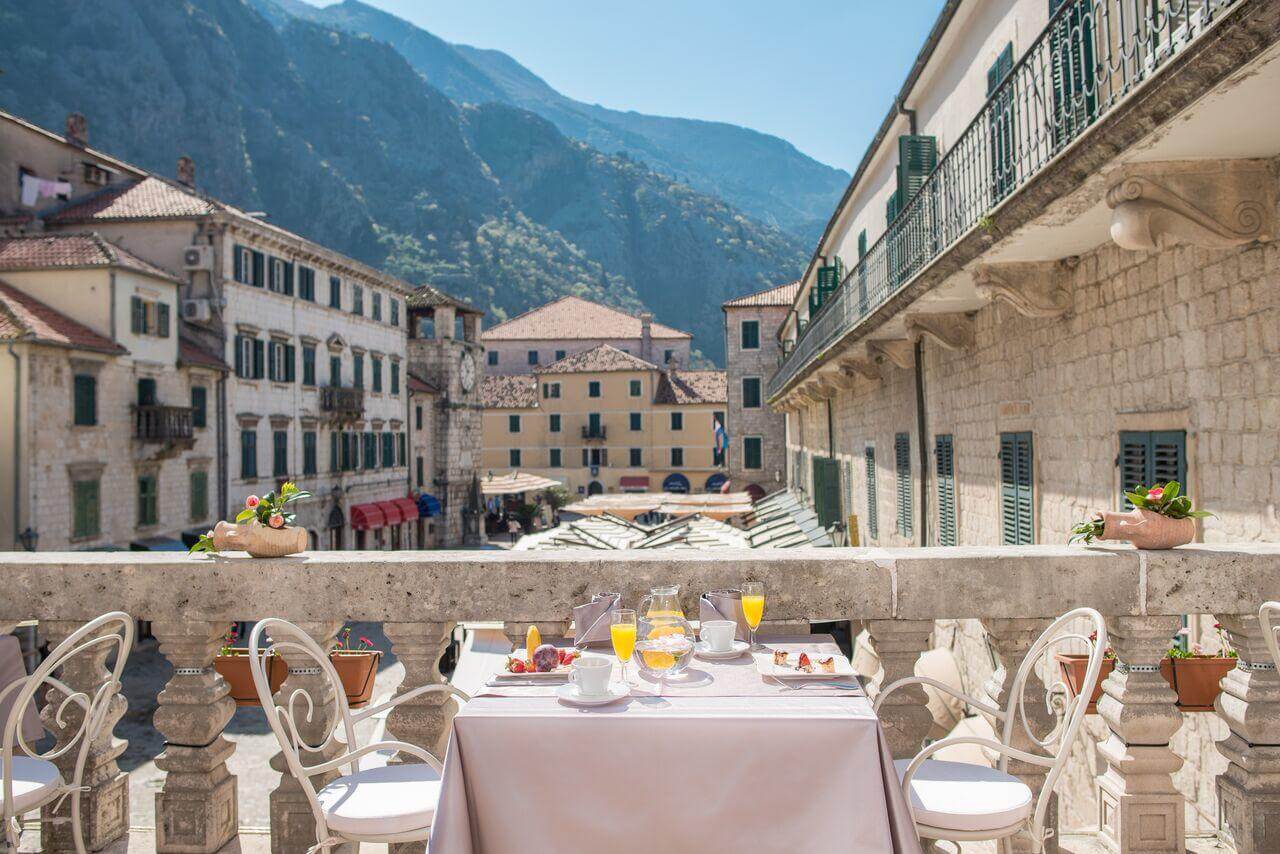 Historic Boutique Hotel Cattaro
Historic Boutique Hotel CattaroRATING: 8.9/10 | LOCATION: Kotor old town | BOOK NOW
Historic Boutique Hotel Cattaro is a historic boutique hotel located in the heart of Kotor Old Town and overlooks Weapons Square.
Housed in the 18th-century former theater, the hotel offers uniquely designed rooms adorned with navy-inspired artworks. All rooms come with flat-screen TVs, en-suite bathrooms, and luxury toiletries.
The hotel also features a restaurant serving local and international cuisine overlooking the old town. The property is air-conditioned and offers free WiFi throughout.
Find Accommodation in Kotor for your Dates
Booking.comGetting to kotor Old Town
Driving to Old Town Kotor
If you're hiring a car (I recommend Localrent.com for car hire in Montenegro) and driving to Kotor there are two parking lots you can use when you’re visiting Kotor old town.
The closest to the old town is across the road, along the marina. It’s usually busy so if you can’t find space there follow the road until you get to the roundabout and turn around and come back.
Since the road through Kotor is also very busy in summer and turning around and coming back could take a long time, I recommend skipping that parking lot and going straight to the one alongside the Škurda River. You’ll usually find a park here and although it’s not as close at the parking lot by the marina it’s still only a few minutes’ walk from the old town.
Parking in Kotor costs 80-90c an hour... a bargain compared to the €10 an hour you pay in Dubrovnik... and that’s still a 15 minute hike from Dubrovnik old town!
Bus to Kotor Old City
Kotor is linked to other towns within the Kotor municipality by a local bus that runs every hour. There is a bus stop in front of Nikola Djurković Culture Center (for the bus heading towards Perast). In the opposite direction, the bus stop is across the road. These bus stops are called ‘Riva’.
You can find the local bus timetable here.
Kotor’s main bus station is a 5-10 minute walk from the old town and you can get a bus to Kotor from any other town in Montenegro. There are also dozens of buses to Kotor from other countries like Croatia, Serbia, and Bosnia and Herzegovina.
Click here to find bus connections to Kotor.

If you are visiting Kotor, my guide to Kotor old town is an indispensable book to take with you. This guide is like having a local best friend to show you the most interesting sights and hidden gems of Kotor.
Kotor Old Town History
To get the most out of your time in Kotor, it helps to have a general understanding of the history of the town. That way, you’ll be able to understand how the town got its unique shape and culture.
Kotor was founded in Špiljari canyon, on the hill above the current old town, in the Bronze Age, somewhere between the 6th and 3rd centuries B.C. Around the 3rd century B.C. the Illyrians consolidated power in the Bay of Kotor, but by 167 B.C. the Roman Empire had conquered them and taken over.
Around the 1st century A.D., Kotor’s settlement moved from the canyon down to the shore, but it was a minor town, and the nearby town of Risan was still the center of power in the Bay of Kotor. But as invasion became more of a threat in the 4th and 5th centuries, fortified towns like Kotor
became more important. By the 6th century, Kotor was part of the Byzantine Empire until it was conquered by the Nemanjić Dynasty of Serbia in 1185.
The Middle Ages (5th – 15th centuries) was a golden era for Kotor. Kotor was a powerful cultural, trade, and economic center that linked the Balkan
Peninsula with the rest of the world. Raw materials, like iron ore from mines throughout the dynasty, were brought to Kotor to be transported by ship and sold to other empires. Kotor had its own culture, a fleet of ships, and was self-governed. With a ready source of raw materials, Kotor became a hub for craftsmen and Kotor’s goldsmiths were known throughout the Mediterranean. Many of the most valuable pieces in Kotor’s churches are from Kotor’s goldsmith school.
After the Serbian Empire fell apart, Christian Kotor felt the threat of the Muslim Ottoman Empire and turned to the Republic of Venice for protection.
The Venetians ruled Kotor from 1420 to 1797 and invested heavily in construction, which is why you’ll often hear Kotor called a Venetian walled city.
From the beginning of the 16th century, Kotor began to lose importance as a trade center, but it was still valuable as a fortified city. The Venetians had completely fortified the town in the 15th century at enormous cost. In fact, Kotor’s fortifications are estimated to be the most expensive in Europe, but those walls saved Kotor from numerous sieges.
After Venice fell in 1797, Kotor was ruled by the Austro-Hungarian Empire,then at the start of the 19th century Napoleon took Kotor. At the end of World War I Kotor became part of the Kingdom of Yugoslavia and its name was changed from Cattaro to Kotor. After World War II ended in 1945, Kotor belonged to the Socialist Federal Republic of Yugoslavia until its disintegration in the 1990s. It was briefly part of the union of Serbia and Montenegro until Montenegro declared independence in 2006.
Frequently Asked Questions About Kotor Old Town
Does Kotor have an old town?
Does Kotor have an old town?
Yes, Kotor has a well-preserved old town, characterized by cobblestone streets, historic buildings, and fortified walls. It's a UNESCO World Heritage site and a must-see for any visitor to Montenegro.
Where is the entrance to Kotor Old Town?
Where is the entrance to Kotor Old Town?
The main entrance to Kotor Old Town is through the Sea Gate, located near the marina. This gate was built in 1555 and serves as a grand entry to the historic center.
Why is Kotor famous?
Why is Kotor famous?
Kotor is famous for its stunning natural setting, nestled between mountains and the Bay of Kotor. It's also renowned for its well-preserved medieval old town, fortified walls, rich maritime history, and abundance of cats.
Is Kotor Old Town worth visiting?
Is Kotor Old Town worth visiting?
Absolutely. Kotor Old Town is a UNESCO World Heritage site full of historical landmarks, charming streets, and beautiful squares. It offers a glimpse into the area's rich past and is perfect for exploration on foot.
Can you walk around Kotor, Montenegro?
Can you walk around Kotor, Montenegro?
Yes, Kotor is a walkable city, especially the old town, which is best explored on foot. There are also hiking trails like the one to San Giovanni Fortress for more active exploration.
How do you get around in Kotor?
How do you get around in Kotor?
Kotor Old Town is pedestrian only, so you walk around it. For longer distances, you can get taxis, public buses and rental cars.
Is 1 day in Kotor enough?
Is 1 day in Kotor enough?
While you can see the main highlights in a day, Kotor offers enough history, natural beauty, and local culture that you can easily spend 3 to 7 days here. It’s also a convenient base for exploring the rest of Montenegro on day trips.
Is Kotor a party town?
Is Kotor a party town?
Kotor is not primarily known as a party town. It has a more laid-back atmosphere focused on history and natural beauty. However, you’ll find lots of bars and pubs and a big nightclub called Maximus inside the town walls.
How long to walk Kotor walls?
How long to walk Kotor walls?
It takes about 2 hours to walk the fortified walls of Kotor, depending on your pace and how often you stop for photos or to admire the view.
How long does it take to walk up Kotor Fortress?
How long does it take to walk up Kotor Fortress?
The hike to San Giovanni Fortress takes about 1.5 to 2 hours, depending on your pace. The trek offers breathtaking views of Kotor Bay.
How many steps is Kotor Castle?
How many steps is Kotor Castle?
The climb to San Giovanni Fortress includes around 1,350 steps. It's a strenuous but rewarding hike.
How much does it cost to go to the fortress of Kotor?
How much does it cost to go to the fortress of Kotor?
The entrance fee for the fortress of Kotor is €8 per person. The entrance fee is charged between 8am and 8pm from spring through fall.
- Home
- Things to Do in Montenegro
- Kotor Old Town

